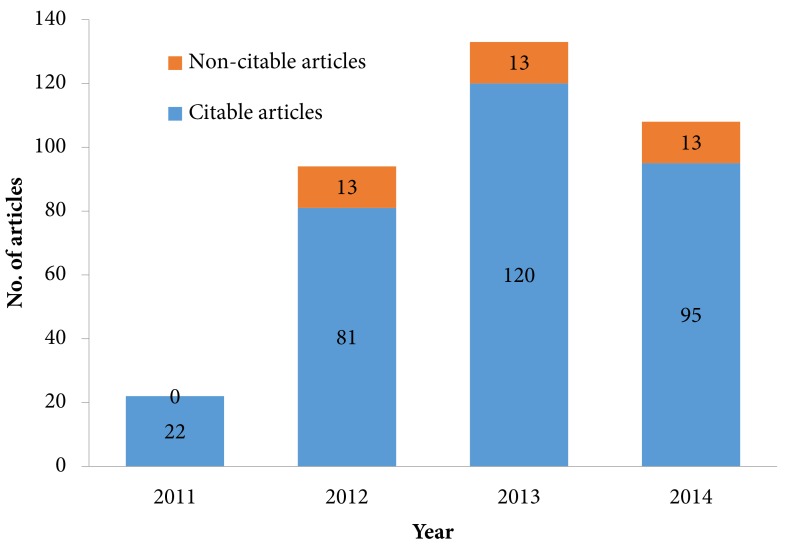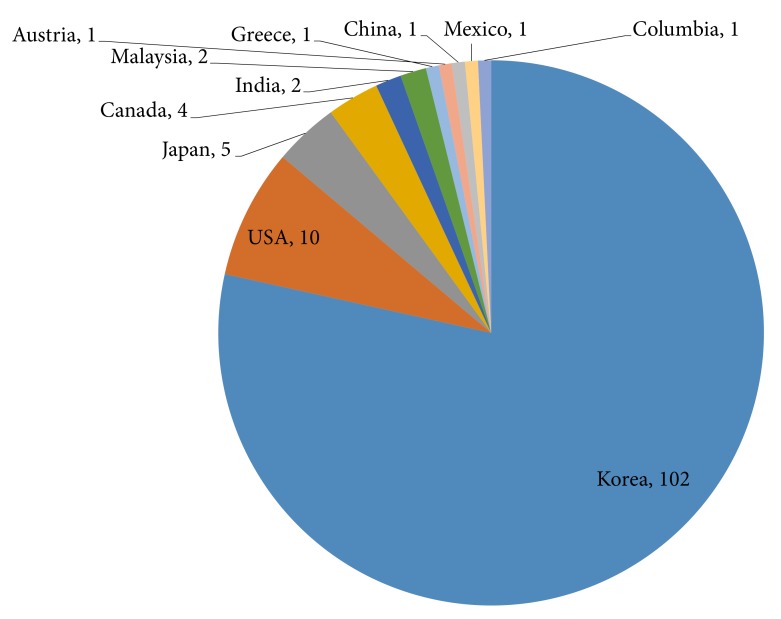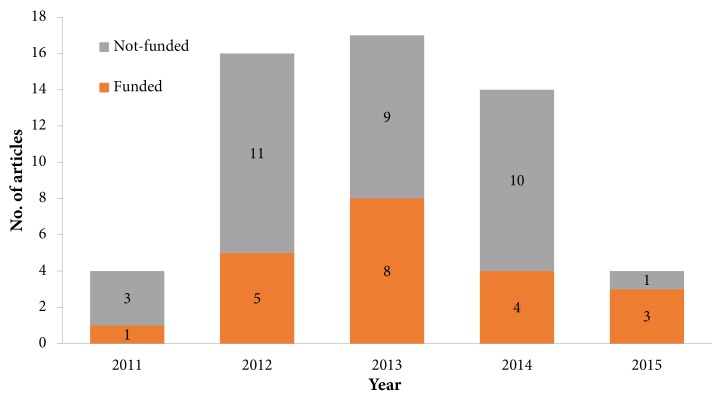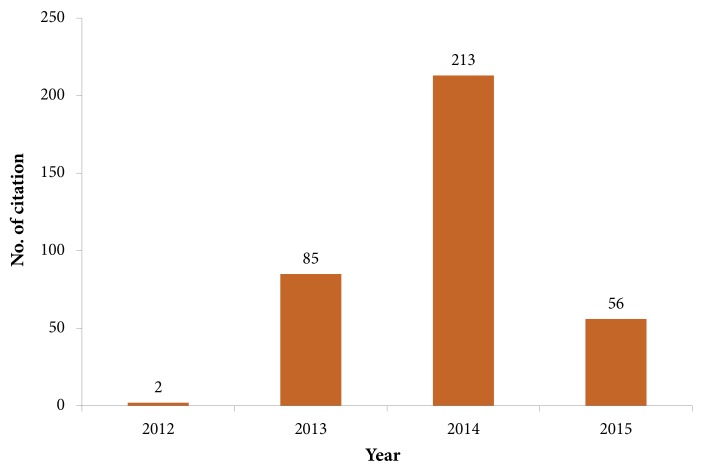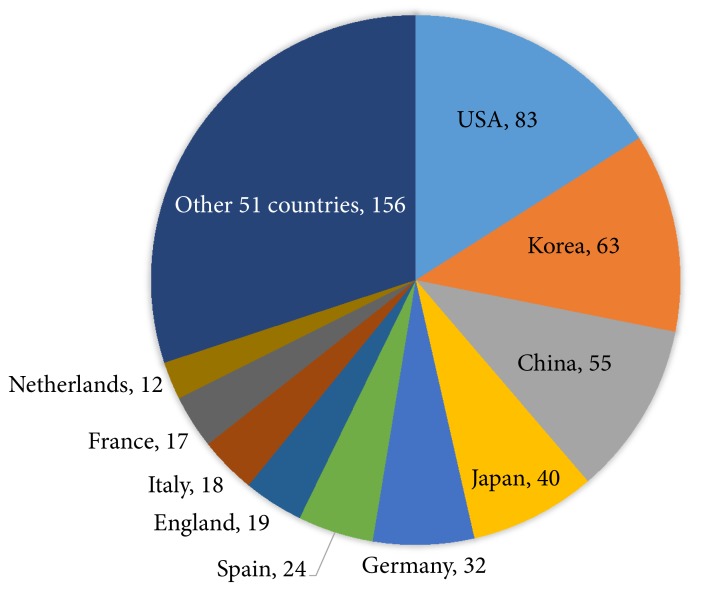INTRODUCTION
Clinical Endoscopy has been the official journal of the Korean Society of Gastrointestinal Endoscopy since 1981. The present journal title continues the Korean Journal of Gastrointestinal Endoscopy as of 2011. After the journal became an English-only journal in 2011, it began to be promoted rapidly as an internationally circulated journal. It was indexed in KoreaMed Synapse on September 22, 2011; PubMed Central (PMC)/PubMed on June 28, 2012; and Scopus on November 11, 2013. In 2013, its SCImago Journal Rank 2-year citations per document score was 0.98. Its ranking in the category of gastroenterology was 56.0%. SCImago Journal Rank is one of the indicators provided by Scopus that shows the visibility of journals in Scopus. Since Clinical Endoscopy is not yet indexed in the Web of Science, this study analyzes the journal metrics based on the Web of Science in order to ensure an unbiased assessment. The results of this analysis will help contextualize Clinical Endoscopy within the worldwide journal market.
MATERIALS AND METHODS
The following journal metrics were analyzed from the journal's homepage and the Web of Science: the number of citable articles from 2011 to 2014, number of countries of affiliation of the contributors from 2011 to 2014, the number of articles supported by research grants from 2011 to February 2015, total citations from 2011 to 2014, the impact factor from 2013 to 2014, citing journals from 2011 to April 2015, the national affiliation of citing authors from 2014 to April 2015, and the Hirsch index. The specific calculation methods were the same as those used in a previous article dealing with journal metrics.1 These metrics are explained briefly below.
Citable articles are original articles, reviews, brief reports, and case reports. Non-citable articles are editorials, commentary, letters, correspondence, meeting abstracts, erratum, corrigendum, and retractions. Total citation is the total cited number by Web of Science journals in a specific year. The impact factor shows how rapidly the journal contents are used; therefore, it is high in rapidly developing areas of research. It can be calculated as follows:
Number of articles from the Web of Science in 2013 citing articles from a target journal published in 2011: A
Number of articles from the Web of Science in 2013 citing articles from a target journal published in 2012: B
Number of citable articles from a target journal published in 2011: C
Number of citable articles from a target journal published in 2012: D
2013 Impact factor of target journal=(A+B)/(C+D)
The Hirsch index is defined as the number of papers with a citation number=h. A journal has index h (the Hirsch number) if h of his or her Np (number of published) papers have at least h citations each and the other (Np-h) papers have equal to or less than h citations each.
RESULTS
Number of citable and non-citable articles
A total of 357 articles, of which 318 were citable, were published from 2011 to 2014. The data according to year are presented in Fig. 1.
Number of countries of affiliation of contributors
The 127 articles published from 2014 to January 2015 were written by contributors from 11 countries, and the proportion of contributors from each country is presented in Fig. 2.
Number of articles supported by research grants
The number of original articles supported by research grants from 2011 to January 2015 is presented in Fig. 3. Twenty-one of the 55 original articles (38.2%) published during this time period were supported by research funding.
Total citations from the Web of Science
A total of 167 articles were cited at least once by 377 articles indexed in the Web of Science. The total citations by year are shown in Fig. 4.
Impact factor from the Web of Science
The impact factor from the Web of Science can be calculated as follows:
Number of articles from the Web of Science in 2013 citing articles from Clinical Endoscopy published in 2011: 17
Number of articles from the Web of Science in 2013 citing articles from Clinical Endoscopy published in 2012: 52
Total: 69
Number of citable articles from Clinical Endoscopy published in 2011: 22
Number of citable articles from Clinical Endoscopy published in 2012: 81
Total: 103
2013 Impact factor=(17+52)/(22+81)=69/103=0.670
Number of articles from the Web of Science in 2014 citing articles from Clinical Endoscopy published in 2012: 79
Number of articles from the Web of Science in 2014 citing articles from Clinical Endoscopy published in 2013: 110
Total: 189
Number of citable articles from Clinical Endoscopy published in 2012: 81
Number of citable articles from Clinical Endoscopy published in 2013: 120
Total: 201
2014 Impact factor=(79+110)/(81+120)=189/201=0.940
Which journals cited Clinical Endoscopy?
Clinical Endoscopy has been cited in more than 100 journals on the Web of Science, according to an analysis performed on April 18, 2015. The 10 journals that most frequently cited Clinical Endoscopy were: World Journal of Gastroenterology (55), Endoscopy (22), Gastrointestinal Endoscopy (11), Digestive Endoscopy (10), Journal of Gastroenterology and Hepatology (8), Photodiagnosis and Photodynamic Therapy (7), Digestive Diseases and Sciences (7), Gut and Liver Gastroenterology Research and Practice (6), and Endoskopie Heute (6).
National affiliation of authors who cited Clinical Endoscopy
Authors affiliated with institutions in 61 countries cited Clinical Endoscopy, as shown in Fig. 5. The United States, Korea, and China were the most common countries for citing authors to live in.
Hirsch index
As shown in Table 1, six articles were cited at least six times each. The next most cited article was cited fewer than seven times, making it impossible to find seven articles that were cited at least seven times each. Therefore, the Hirsch index is 6.
DISCUSSION
The 2014 impact factor of 0.940 corresponds to a 2013 Journal Citation Report score of 89.3% (the 67th most cited of 75 journals) in the category of gastroenterology. This reflects a tremendous improvement with regard to citation frequency. It would appear that the official journal of the Korean Society for Gastrointestinal Endoscopy had been under-estimated due to the language barrier and the lack of database platform indexing. Beginning in 2006, PMC Extensible Markup Language (XML) began to be applied widely in Korea. At that time, the primary purpose of full-text XML publications was to add medical journals from Korea to PMC and PubMed. After being included in PMC, the impact factor and total citations of medical journals from Korea dramatically increased.2 This phenomenon occurred in the case of Clinical Endoscopy as well. Therefore, it is routine for biomedical societies in Korea to produce PMC XML or Journal Article Tag Suite (JATS) XML files of their journals in order to add them to PMC.34 Some journal metrics for medical journals from Korea have been reported, with results comparable to those described in the present article. After becoming English-only and being indexed in PMC/PubMed, Korean medical journals have shown a consistent increase in the impact factor, total citations, the number of countries of contributors, and the Hirsch index.567891011
The fact that recent contributors are from 11 countries demonstrates that Clinical Endoscopy is widely disseminated (Fig. 2). Moreover, authors from 61 countries have cited Clinical Endoscopy (Fig. 5), which was likewise enabled by the journal's open access policy and the fact that it is indexed in PMC/PubMed. Due to these policies, the journal is more accessible to physicians and researchers worldwide.
It is known that review articles are generally the most frequently cited type of article. In this analysis, four review articles and two original articles were found to be the most frequently cited articles published during the time interval that we studied (Table 1). The recruitment of high-quality original articles is another strategy for increasing citation frequency. Recruiting contributions from endoscopy societies in other countries is necessary to increase the diversity of contributors. International recruitment may also be a strategy for broadening and increasing the target readership. Manuscripts supported by research funding agencies should be actively recruited to Clinical Endoscopy. Research output funded by agencies has presumably passed a review process before submission and is of higher quality, as shown by the fact that such studies have already attracted financial support.
Although Clinical Endoscopy has recruited manuscripts from all over the world and ensured that all manuscripts are edited professionally, several areas for improvement remain. First, the aims and scope of the journal should be described more precisely and the unique qualities of Clinical Endoscopy should be emphasized. The current aims of the journal are 'to promote the exchange of up-to-date scientific information that disseminates both clinical and experimental studies in gastrointestinal endoscopy.' Second, new technological innovations relevant to the domain of academic publishing should be introduced as soon as possible. Such innovations include the Open Researchers and Contributors ID (ORCID),12 CrossMark, FundRef,13 and CrossRef Text and Data Mining.14 ORCID provides a unique ID for each researcher. CrossMark verifies that the version of an article accessed at a given time is the most recent and reliable version of that article. FundRef provides a unique ID for each funder. CrossRef Text and Data Mining tools allow convenient meta-analysis or systemic review by immediately identifying the most relevant articles, and they are technologically grounded in the automated analysis of CrossRef metadata including CrossRef Text and Data Mining license info for access to full text. These services can be integrated into JATS XML and CrossRef XML.15
In conclusion, once the language policy of Clinical Endoscopy was changed to English-only, the journal was made open-access, and it became widely indexed, Clinical Endoscopy made extraordinary progress in becoming an internationally recognized journal, as shown by journal metrics originating from the Web of Science. This achievement was made possible by the time and dedication of the editors and editorial board members. The 2014 impact factor of 0.940 is one of the key pieces of evidence showing the progress of Clinical Endoscopy.



